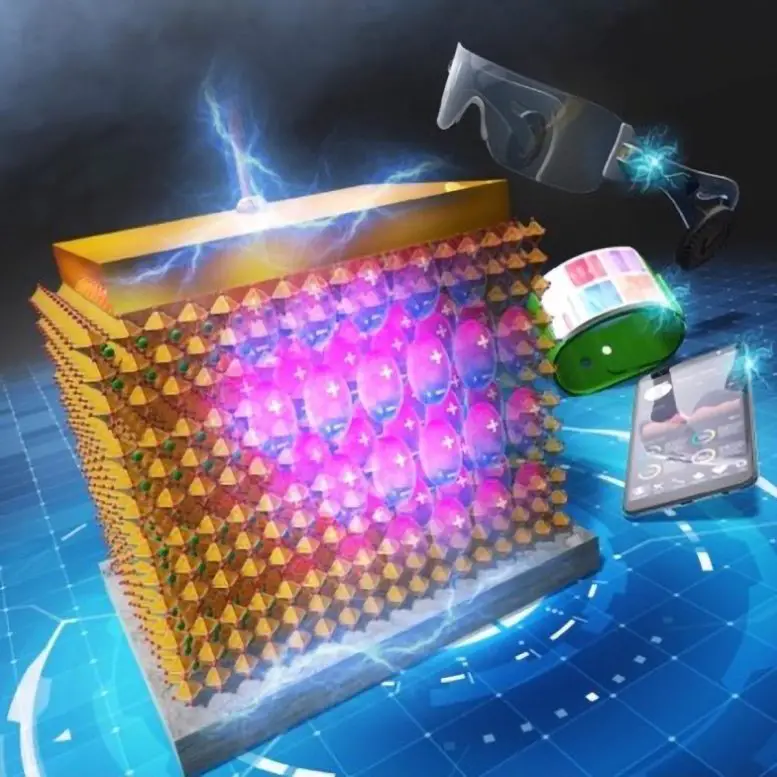Ultrahigh Energy Storage in 2D High-κ Perovskites. Credit: Minoru Osada, Nagoya University
Researchers have developed an advanced dielectric capacitor using nanosheet technology, providing unprecedented energy storage density and stability. This breakthrough could significantly enhance renewable energy usage and electric vehicle production.
Groundbreaking Dielectric Capacitor Development
A research group, led by Nagoya University in Japan, has innovatively applied nanosheet technology to create a dielectric capacitor. This development holds significant implications for advanced electronic and electrical power systems. Innovations in energy storage technology are vital for the effective use of renewable energy and the mass production of electric vehicles. The dielectric capacitor stands as a major advancement in technology, boasting the highest energy storage density ever recorded. Other beneficial features include a quick charging time, high output, longevity, and superior high temperature stability.
Collaboration and Key Findings
The research group, headed by Professor Minoru Osada at the Institute for Materials and Systems for Sustainability (IMaSS), Nagoya University, collaborated with NIMS. Together, they developed a nanosheet device displaying an unprecedented energy storage performance. Their groundbreaking results were featured in the journal, Nano Letters.
The Need for Energy Storage Innovations
Innovations in energy storage technology are crucial for the optimal utilization of renewable energy and the mass production of electric vehicles. Existing energy storage technology, such as lithium-ion batteries, possess limitations. These include long charging times and issues such as electrolyte degradation, reduced lifespan, and even risks of spontaneous ignition.
Dielectric Energy Storage Capacitors: A Promising Alternative
Dielectric energy storage capacitors have emerged as a promising alternative. These capacitors possess a sandwich-like structure composed of two metal electrodes separated by a solid dielectric film. Dielectrics, materials that store energy via a physical charge displacement mechanism known as polarization, are key. As an electric field is applied to the capacitor, the positive and negative charges are attracted toward opposite electrodes, facilitating the storage of electrical energy.
“The dielectric capacitors have many advantages, such as a short charging time of only a few seconds, long life, and high power density,” Osada noted. However, the energy density of current dielectrics is significantly lower than the increasing electrical energy demands, implying a need for enhancement.
Nanosheet Layering: The Innovation Key
The energy stored in a dielectric capacitor is linked to the amount of polarization. Consequently, a high energy density can be achieved by applying an electric field as high as possible to a high dielectric constant material. Existing materials, however, are limited by their electric field capacity.
To surpass this, the group utilized nanosheets comprised of calcium, sodium, niobium, and oxygen with a perovskite crystal structure. “The perovskite structure is known as the best structure for ferroelectrics, as it has excellent dielectric properties such as high polarization,” Osada explains. “We found that by using this property, a high electric field could be applied to dielectric materials with high polarization and converted into electrostatic energy without loss, achieving the highest energy density ever recorded.”
Implications and Applications
The nanosheet dielectric capacitors showed an energy density 1-2 orders of magnitude higher than their predecessors, while maintaining the same high output density. Excitingly, the nanosheet-based dielectric capacitor achieved a high energy density that maintained its stability over multiple cycles of use and was stable even at high temperatures up to 300°C (572°F).
“This achievement provides new design guidelines for the development of dielectric capacitors and is expected to apply to all-solid-state energy storage devices that take advantage of the nanosheet’s features of high energy density, high power density, short charging time of as little as a few seconds, long life, and high temperature stability,” Osada said. “Dielectric capacitors possess the ability to release stored energy in an extremely short time and create an intense pulsed voltage or current. These features are useful in many pulsed-discharge and power electronic applications. In addition to hybrid electric vehicles, they would also be useful in high-power accelerators and high-power microwave devices.”
Reference: “Ultrahigh Energy Storage in 2D High-κ Perovskites” by Hyung-Jun Kim, Shu Morita, Ki-Nam Byun, Yue Shi, Takaaki Taniguchi, Eisuke Yamamoto, Makoto Kobayashi, Yasuo Ebina, Takayoshi Sasaki and Minoru Osada, 1 May 2023, Nano Letters.
DOI: 10.1021/acs.nanolett.3c00079


